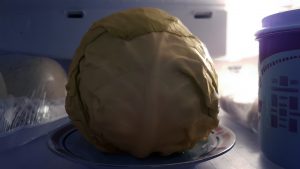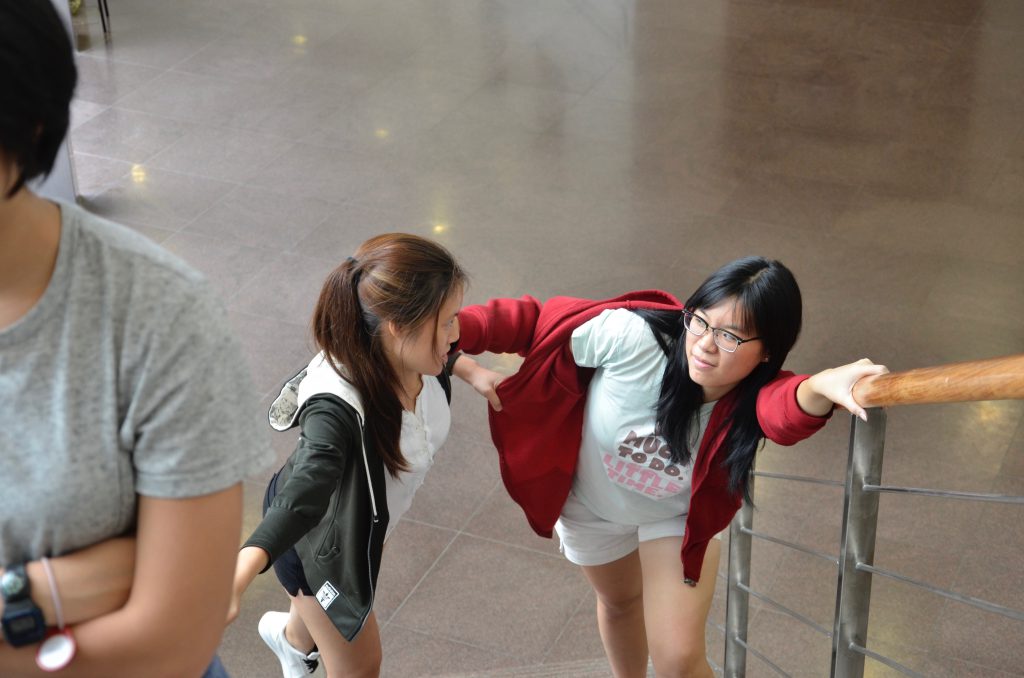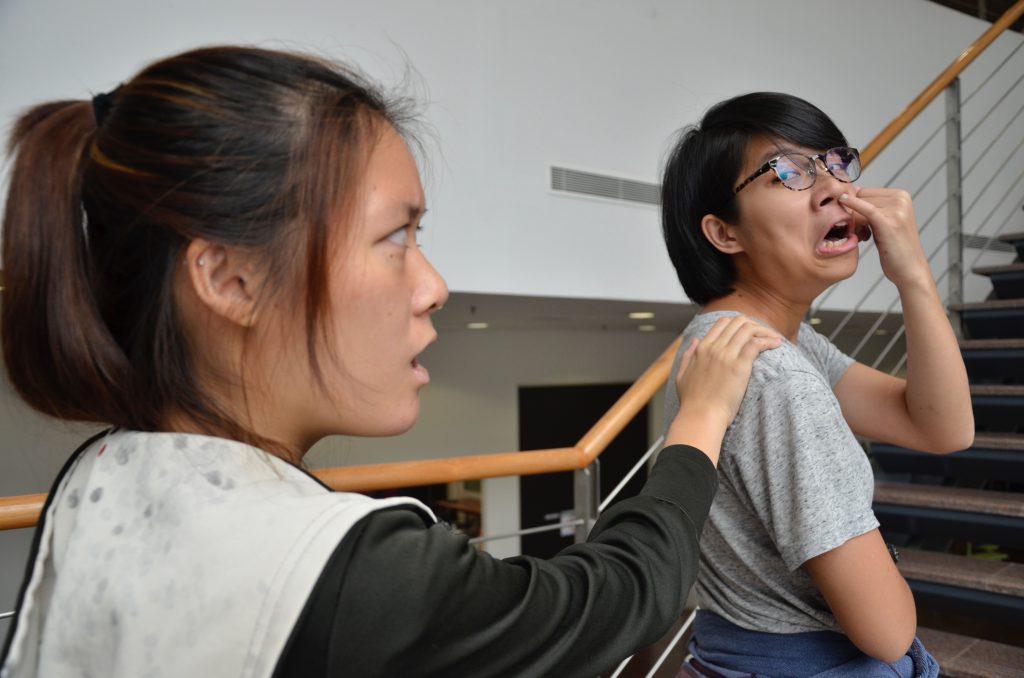Our group or as known as Ling Teh Kam-pany (Derived from our names), consists of Kam Yit Ling, Clara Teh Ke Wei and myself, Seng Yi Ling. And here, we present to you our very own movie trailer for our final 4D assignment of Year 1 Semester 1…
Movie Title: Yi(t) Ling
Genre: Fantasy + Psychological Horror
3 Act Structure
Beginning (Act 1)
Yi Ling is a shy and quiet person. Once focused on a task, she is far from being distracted. Sadly, she is ostracized by her classmates as she seemed rude and had a stuck up attitude. Her classmates disliked and gave her a hard time. Until one day, her new classmate Queenie decided to befriend her.
Rising action
To her dismay, Queenie sold Yi Ling out to fit in as she got ostracized by their classmates when she was seen hanging out with Yi Ling. She ganged up with her classmates and forced Yi ling into room rumored to be haunted for fun’s sake. When Yi Ling managed to open the door after much struggling, she was transported to another dimension where there were doors which led her to places as a ghost tailed her.
Middle (Act 2)
Encounters with the ghost tells Yi Ling that the ghost wants her to stay in this dimension and never go back. The spirit was motivated by loneliness which both characters shared and was enraged when Yi Ling refused to stay.
Ending (Act 3)
The ghost is in actual fact a manifestation as her alter ego. The other dimension filled with doors was a symbolism of change Yi Ling faced in her life. And the only way Yi Ling can get back to her world is by killing a part of her: Her Alter Ego.
References
We watched many horror movie trailers as a form of research and shared our experiences and views on past movies we’ve watched that could be of assistance to our movie trailer! 🙂
Crimson Peak (The Ghost was constantly present, but not shown blatantly.)
Black Swan (Killing of her Alter Ego)
The Babadook (Ghost was a manifestation of main character’s fears.)
The Boy ( Placement of background music.)
Placement of background music was very on point here – it had us 3 covering our ears and half shutting our eyes in fear to watch the trailer. The initial beginning of the trailer has a soft mellow piano tune when the female lead approaches the mansion, and the drastic change of music when they revealed The Boy to her sent shivers down our spine. The sudden change of music instantly let the viewers know what atmosphere the trailer aims to set: Simple life of the girl -> Horror of her lifetime.
Blair Witch Project (Handheld camera shots to show desperation and fear.)
https://www.youtube.com/watch?v=D51QgOHrCj0
Coraline (Travelling into another dimension, and use of different colour for different world)
In Coraline, the saturation of her world is low and colours are dull like the reality she lives in. In the other dimension, she enters a door where saturation is high and colours are vibrant and lively like the life she yearns to live in.
Editorial
Blackout shots – Blackout transition shots are a recurring motif. It is used as a representation of time lapse. When used in our trailer, the following scene will be of another place and another time. In addition, length of transition creates suspense and indicate a tonal shift in the scene.
Color – Adjusting of color to establish different dimensions were used. In the real world, colors are more saturated and was brighter; whereas in the other dimension, saturation was kept to a minimum and brightness was decreased to emphasize on the stark differences in both worlds, so as to make it more spooky.
Background music and audio – Music were used to build up the anticipation and gives the audience the emotion they ought to be feeling a specific sections of the trailer. For instance, mellow piano music at the start to give a soothing feeling, and high pitched fast paced music at the climax when main character was being chased down.
Shots Established
Still Shot was used at the start of the trailer, where a serene feeling is given of the school environment. (0:09)
Fast Pan + POV at the scene where main character looks around perplexed at the new dimension she entered (0:49) .
Dolly In and Out scenes are present at the scene to show the ominous door (0:30) and the scene where zooming in on her expression to show that she is perplexed after opening the door to another location (0:48).
Mid-shot was used at the scene where main character is pleading the classmates to let her out. (0:40)
Handheld shot when the main character is running up the stairs. (1:01)
Low Angle Shot at the scene where 3 Classmates (Dawin, Jon, JiaQi – Thanks guys!) were gossiping about the main character. (0:22)
Trucking Shot was used when classmates (Thanks Queenie and Debbie!)were pushing the main character inside the haunted room. (0:35)
Close-up Shot was used when main character was wrenching at the door handle when she is locked in (0:41). And the part where the main character’s phone is ringing (1:25).
Canted angle shot are present when phone is dropped amidst the struggle when pushing the main character inside the haunted room (0:37), and the scene where the ghost is wrenching the door to be opened (1:14). This is to create drama and suspense.
Challenges Faced
- We tend to forget that the trailer is 2 mins and thus, eventually worry that our trailer does not convey our plot properly; but at the same time we don’t want our trailer to be a 2 min summary of the movie (given that it is a MOVIE trailer).
- Finding an appropriate location which conveyed the intended feeling was not easy. Our main character’s setting is in a school environment and hence the school was used. But for the horror aspect we had to find narrow and dark areas within campus and that was difficult. Given that we even trespassed ongoing construction sites in school.
- Suitable. background. music. was. really. hard. to. find.
- Miss Ruyi mentioned that our logo and lobby music was not very appropriate for our Horror trailer, but our group felt that the logo was a good representation of our efforts as a group and the elevator music gave it a merry feeling. This will create the drop of emotions when the horror aspects of our trailer is revealed. 🙂
- Bar chart results obtained from Ms Ruyi’s Google survey for our group were more towards the positive end of the spectrum. (thank you!)
- Sound effect can be toned down to hear narration of the alter ego better in the end.
- The starting music doesn’t match with the rest of the trailer , perhaps a non jazzy music that foreshadows the story?
- Show that the alter ego and the main character are two compelling personalities/ people by including more interactive scenes between the 2. Perhaps by voice over of dialogue between 2 person or a struggle between the 2.
- Yi Ling can act! (Yi Ling says thank you >~< )
- There were different shots to show the mood of the character.

Our first and hopefully not the last group photo as Ling Teh Kam-pany 😀





















 The setup (Exposition) consists of the facts the audiences need to know, like the establishment of characters an motive
The setup (Exposition) consists of the facts the audiences need to know, like the establishment of characters an motive YES. I had really high expectations of this movie initially because the male lead was Jason Statham, the actor in one of my all time favorite action movie, ‘The Transporter’.
YES. I had really high expectations of this movie initially because the male lead was Jason Statham, the actor in one of my all time favorite action movie, ‘The Transporter’.





 ~~~~~~~~~~~~~~~~~~~~~~~~~~~~~~~~~~~~~~~~~~~~~~~~~~~~~~
~~~~~~~~~~~~~~~~~~~~~~~~~~~~~~~~~~~~~~~~~~~~~~~~~~~~~~




